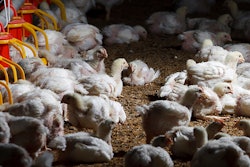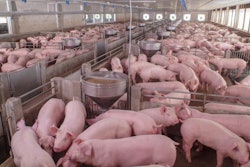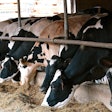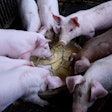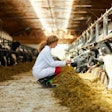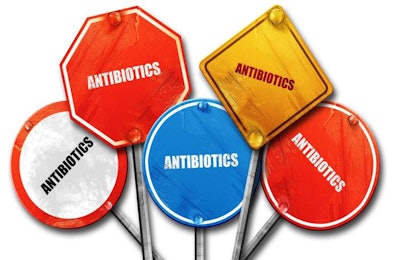
Over the past decade, sales of veterinary antibiotics have fallen by more than one-third, according to the latest survey of antimicrobial use in food-producing animals in European countries.
Total sales of veterinary antibiotics in European countries dropped by more than 34% between 2011 and 2018, according to the latest report on European Surveillance of Veterinary Antimicrobial Consumption (ESVAC). This — the 10th report in the ESVAC series — was published recently by the European Medicines Agency (EMA).
Participating in this latest survey were 30 countries of the European Union and the European Economic Area, plus Switzerland. Each submitted data on sales of antimicrobial veterinary medicinal products (AVMP) – or on prescriptions in the case of two countries.
A population correction unit (PCU) was applied as a proxy for the size of the food-producing animal population in each country. The main indicator used in the current report to express the sales is milligrams of active ingredient sold per population correction unit (mg/PCU). Species covered included dairy cows, cattle, sheep, goats, pigs, chickens, turkeys, rabbits and horses. Calculations took account of live animal imports and exports.
As the use of antimicrobials for growth promotion has been banned in the European Union since 2006, the data sets provided by the participating nations cover exclusively sales of antimicrobials sold for veterinary medicinal purposes.
Key findings in the latest survey
For all 31 countries, total sales of AVMP in 2018 were 6,500 metric tons of active ingredients. Of this total, just 1.1% was in tablet form, and the rest was categorized as “all other pharmaceutical forms.”
There was wide variation in AVMP sales between countries, ranging from just under 3.0 to more than 466 mg/PCU. The mean was calculated at around 103 mg/PCU, and the median value was 57 mg/PCU.
Three classes of AVMP accounted for 68% of total sales in terms of mg/PCU. These were the tetracyclines (31%), penicillins (29%) and sulfonamides (8%).
Included in the study were antimicrobials classified by the World Health Organization (WHO) as highest priority, and critically important for human medicine (CIAs). In this category, macrolides constituted 7.7% of the total used in food-producing animals, polymixins (including colistin) 3.3%, fluoroquinolones 2.5%, other quinolones 0.3%, and 3rd– and 4th-generation cephalosporins 0.2%. Again, there was great variation between participating countries in sales of these CIAs.
Overall, sales (mg/PCU) of pharmaceutical forms suitable for group treatment accounted for 88% of the total sales. Premixes accounted for 27%, oral powders for 9%, and oral solutions for 52%. Sales of forms for group treatment ranged from 2% to 95%. Those forms intended for treatment of individual animals — accounting for 12% of total sales — comprised mainly injectable preparations (11.4%). Just 0.6% was intramammary preparations, and 0.3% was covered by oral pastes, boluses and intrauterine preparations.
Of those products intended for group treatment, 88% contained a single active ingredient. In some countries, products were sold that contain as many as four active ingredients.
Trends in AVMP use in Europe
After a request from the European Commission to develop a harmonized approach to the collection and reporting of data from EU Member States on the use of antimicrobials in animals, the EMA launched the first ESVAC project in 2009. It has since been conducted annually.
While early ESVAC reports had lower participation, 25 countries have provided sales data each year between 2011 and 2018 (the time-frame for the latest update).
Overall, the decline in sales (mg/PCU) over this period amounted to almost 35% — from 161.4 mg/PCU in 2011 to 105.6 mg/PCU in 2018. While an increase of 5% of more was registered for five of these countries, 18 registered a reduction of at least 5%. One state has achieved a cut of 58%.
Commenting on the results, Ivo Claassen, head of EMA’s Veterinary Medicines Division, attributed the reduction in antibiotic usage in food-producing animals to guidance from the European Union, as well as national campaigns that promote prudent antibiotic use in animals.
“The steady decrease in sales of veterinary antibiotics over 10 years shows that Europe is on the right track to fight antimicrobial resistance,” he said.
Also in these 25 countries, there has been a marked reduction in use of the CIAs in food-producing animals. Between 2011 and 2018, sales of 3rd- and 4th-generation cephalosporins were down by 24%, polymyxins by 70%, fluoroquinolones by 4.2%, and other quinolones by 74%.
Authors of the report urge caution when comparing data between countries and over time. Variations may arise from differences in the prevalence of bacterial diseases, animal populations, production systems, daily dose rates, pharmaceutical forms, and treatment duration. Furthermore, some participating countries have adjusted their data collection systems.
One Health approach to antimicrobial resistance
Among those welcoming the latest ESVAC report was Cat McLaughlin, chair of the Responsible Use of Medicines in Agriculture Alliance (RUMA) in the United Kingdom.
“It’s very positive to see this downward trend [in antibiotic use in European farm animals] in almost all countries,” she said. “That’s not just in terms of total sales, but also the highest priority antibiotics – 3rd– and 4th-generation cephalosporins, fluoroquinolones and colistin.”
“While the use of antibiotics in food production is not the main driver of antibiotic-resistant infections in people, it can be a contributing factor,” said McLaughlin. “Any use of an antibiotic has the potential to create resistance. As part of a One Health approach, we all have a duty to protect the efficacy of medical and veterinary antibiotics by reducing, refining or replacing use.”


